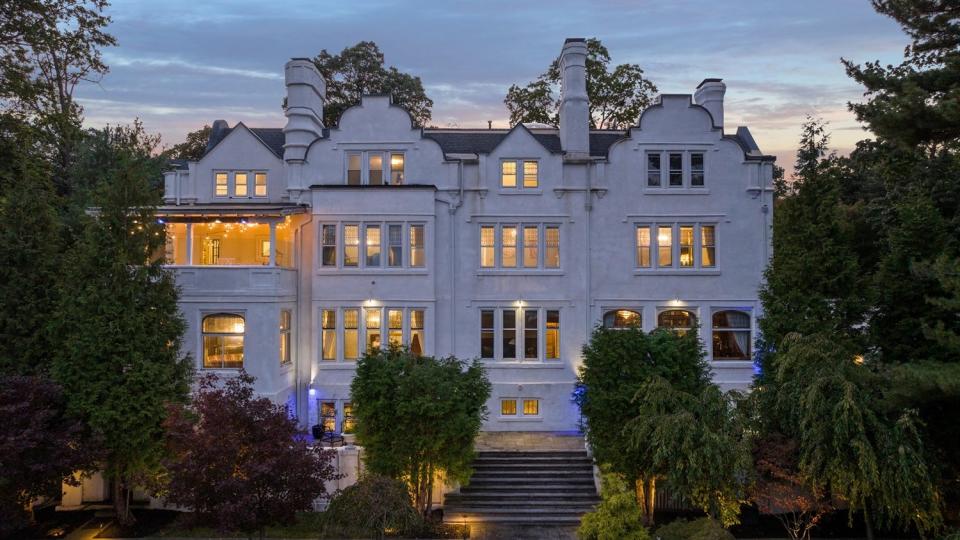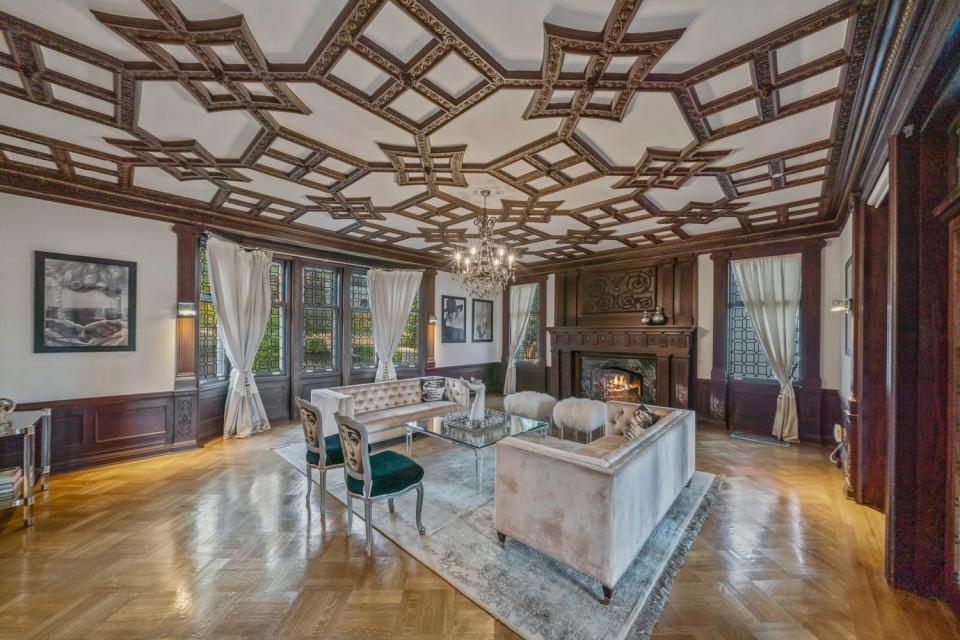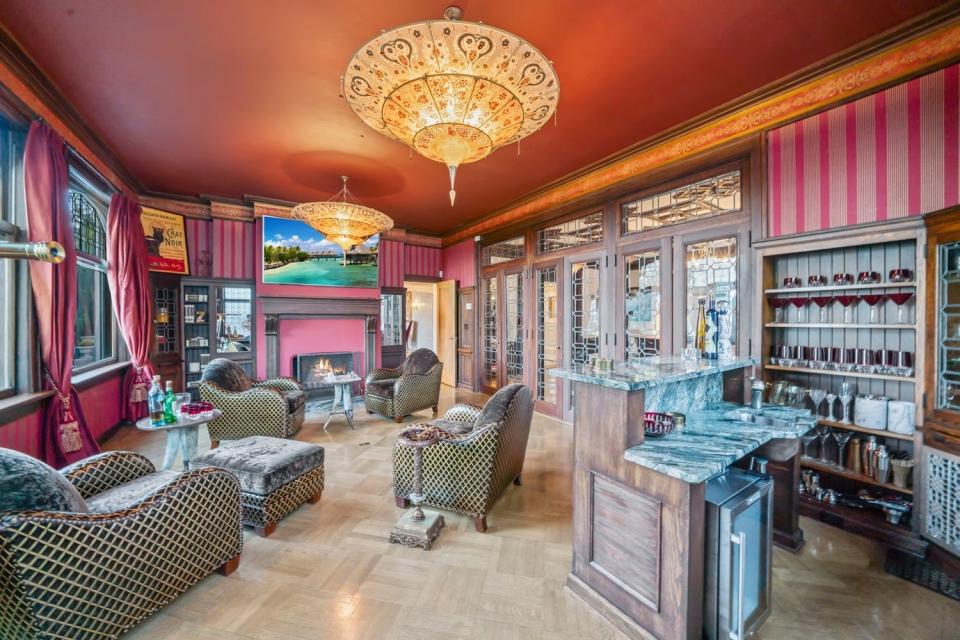Montclair mansion once home to radio personalities and mini golf pioneer listed for $3.5M
Built along a Montclair hillside in 1912, 35 Afterglow Way has been home to some of the town's biggest names.
The massive concrete home overlooking Montclair Kimberley Academy's Upper School housed a longtime CBS radio broadcaster, a miniature golf pioneer and a key player in the U.S. Treasury Department during World War I.
Now the massive Elizabethan-style home is ready for its next owner, having recently been put on the market for $3.5 million. The home has 23 rooms, including a foyer clad in white Calcutta marble, a Parisian-inspired parlor and a ballroom.
It was originally called "Casa Enefer" under its first owner, Robert E. Mills. He was in the spark plug business, working days as the secretary and treasurer of the Rajah Auto Supply Company in Bloomfield. Just a few years later, however, he sold the home to William C. DeLanoy, a New York City insurance broker who served as director of the Bureau of War Risk Insurance for the federal government during World War I.
Created as a division of the Treasury Department, the bureau started under DeLanoy with one assistant and three clerks to manage insurance policies and claims for ships and people, The Montclair Times reported. It grew to hold more than 300 assistants and 14,000 clerks and occupy the National Museum of Natural History.

DeLanoy came to Montclair from Millburn after the war. The home at 35 Afterglow Way stands out but is among hundreds of concrete homes designed by local architect A.F. Norris. Several other Norris homes in Montclair are listed along with 35 Afterglow on the National Registry of Historic Places, including 50 Lloyd Road, 128 N. Mountain Ave. and the J.M. Chapman House at 10 Rockledge Road. The last was illustrated on the cover of American Homes and Gardens in January 1906.
Closter home listed for $1.2 million linked to odd American Revolution story
Norris often featured coffered ceilings, paneled wainscotting and embossed mantels, elements that carried over into 35 Afterglow, registry records show. Outside the massive home are ornate exterior window surrounds, high-stepped gables and terraced gardens in the rear.
Formerly with six bathrooms, the now nine-bedroom home has been restored and remodeled with 10 bathrooms, said Jason Failla, the listing agent with Century 21 The Crossing. It also has been fitted with modern-day amenities, including its own movie theater, and given a new garage. Its original one is now a single-family home that shares part of the driveway, Failla said.
After DeLanoy took ownership, he renamed the home "Casa Deldra." The moniker was a combination of his surname and that of his wife's family, Drake. Drake was also the first name given to the couple's son.

Drake DeLanoy, a talented golfer who rose to prominence at Montclair Kimberley Academy and often was featured on leaderboards at local golf tournaments, left the home in 1926 after eloping with Rosalind Lee in Chestertown, Maryland. The two had met just days before in Atlantic City, where Lee had been working as a stage performer under the name "Lovely Lee" in a show called "Oh, Please."
His mother, who pursued the pair through Delaware and into Maryland, failed to catch them before they wed, The Montclair Times reported. She would soon repossess his car.
Drake DeLanoy was defiant.
"No reconciliation has been effected, and I will do nothing to secure one," he told The Montclair Times in December 1926. "My family has made a lot of trouble for me, and they will have to be the ones to approach me."
4 ways to make a small space look and feel bigger, according to North Jersey designers
Drake DeLanoy would move with his new wife — also an ardent golfer — to New York City, where he and John Ledbetter were becoming pioneers in miniature golf. The two built dozens of rooftop courses, most prominently the one atop the Astor Building on Broadway in New York City.
They also built indoor courses and some in New Jersey, including the old course at Columbia Amusement Park on Hudson Boulevard in North Bergen. The cost when the course opened in 1927 was 15 cents for nine holes, The Paterson Morning Call reported. It was "two bits" to play 18, the paper added.
The courses helped launch a Depression-era craze that brought the "rich man's game" of golf to the masses. Nearly all the courses used Thomas McCulloch Fairbairn's artificial surface, a mixture of cottonseed hulls, sand, oil and dye created in 1922, Dale Samuelson and Wendy Yegoiants wrote in their book "The American Amusement Park." Fairbairn later patented what was then called Tom Thumb Golf with Garnet Carter of Georgia, who modernized course design with hollow logs, sewer pipes and other obstacles.

Drake DeLanoy linked with Fairbairn and founded the Tom Thumb Miniature Golf Association. He also ran Miniature Golf Courses of America, which grossed $6 million in sales in 1930, The Montclair Times reported.
After making it big in the city, Drake DeLanoy would return to Montclair, where he had a home on Gates Avenue. He would also reconcile with his parents. He became chairman of his father's firm, DeLanoy and Kipp. At one point, the firm was the only outside tenant to occupy the Federal Reserve Bank of New York Building on Liberty Street in New York City.
In 1944, after the elder DeLanoy's death, 35 Afterglow Way was sold to Reginald Porter of the Titeflex Company in Newark. The company, since folded into a conglomerate and out of Newark, still makes rigid pipes and flexible hoses for airplane engines.

Porter in 1959 sold the property to Dallas S. Townsend Jr., a Peabody Award-winning CBS radio broadcaster and the son of a former assistant U.S. attorney general. With CBS, Townsend covered space flights from NASA's famed Mercury, Gemini and Apollo projects, the atomic tests in Nevada and the inaugurations of Presidents Dwight D. Eisenhower and John F. Kennedy. He also provided coverage of Kennedy's assassination.
A 1936 graduate of Montclair Kimberley Academy, Townsend spent 44 years at the network in all. Almost all came after spending World War II at U.S. Army signal and communications centers in New Guinea, the Philippines and Japan. After returning home from Japan after the war as an Army captain, he worked as an editor, director and manager for CBS broadcasts. For 25 years, he wrote and anchored the "CBS World News Roundup."
More recently, 35 Afterglow was home to another famous radio personality in Pat St. John. The Detroit native worked at WPLJ-FM for most of the 1970s and '80s as the host of afternoon drive before going to rival WNEW-FM.
In 1998, St. John became one of the first big names to move to satellite radio by joining Sirius as its director of classic rock programming. He was the one to make the famous announcement that Howard Stern would be joining Sirius in 2004. St. John sold 35 Afterglow in 2006 after 15 years of ownership, records show. He and his wife moved to California in 2015.
This article originally appeared on NorthJersey.com: Historic Montclair NJ home for sale: See the listing
